方案详情文
智能文字提取功能测试中
广东海洋大学 不同贮藏条件对红甘鲹鱼片微生物群落及质量变化的影响Effects of different storage conditions on microbial community and quality changes of greater amberjack (Seriola dumerili) fillets使用格哈特公司全自动凯氏定氮仪 维普得VAPODEST 450检测挥发性盐基氮TVBN含量(新鲜度)。The content of TVB-N was determined by the Automatic Kjeldahl nitrogen analyzer (VAPODEST 450,C. Gerhardt GmbH & Co. KG).LWT -Food Science and Technology 179 (2023) 114640ELSEVIERjournal homepage: www.elsevier.com/locate/lwt H. Zhong et al.LWT 179 (2023)114640 Contents lists available at ScienceDirect LWT 不同贮藏条件对红甘够鱼片微生物群落及质量变化的影响 Effects of different storage conditions on microbial community and qualitychanges of greater amberjack (Seriola dumerili) fillets Hongliang Zhong, Shuai Weia,", Mengli Kang, Qinxiu Sun, Qiuyu Xia, Zefu Wang ,Zongyuan Han , Yang Liu, Mingxin Liu , Shucheng Liu aa, a College of Food Science and Technology, Guangdong Ocean University, Guangdong Provincial Key Laboratory of Aquatic Product Processing and Safety, GuangdongProvince Engineering Laboratory for Marine Biological Products, Guangdong Provincial Engineering Technology Research Center of Seafood, Key Laboratory of AdvancedProcessing of Aquatic Product of Guangdong Higher Education Institution, Zhanjiang, 524088, ChinaProcessing Technology Research, Ningbo Academy of Agricultural Sciences, NingBo, 315040, China College of Electrical and Information Engineering, Guangdong Ocean University, Zhanjiang, 524088, China “ Collaborative Innovation Center of Seafood Deep Processing, Dalian Polytechnic University, Dalian, 116034, China ARTICLEINFO ABSTRACT Keywords:Greater amberjack filletsLow temperatureMicrobial communityHigh-throughput sequencing To improve the safety and extend the shelf life of fish fillets, four different temperatures were used to preservethe greater amberjack. The microbial diversity and quality changes were determined. The freezing point ofgreater amberjack fillets was determined by analyzing the freezing curve, and four storage temperatures wereapplied, room temperature (20°C), refrigeration (4°C), ice temperature (-1°C) and partial freezing temperature(-3 °C). The shelf life of greater amberjack fillets stored at 20°C, 4°C,-1°C and -3 °C was 30 h, 7 d, 21 d and 36d, respectively based on TVC and TVB-N results. The microbial community indicated the bacterial richness anddiversity were higher at the end of the storage time under -1°C and -3 °C. Pseudomonas was the specific spoilagebacteria of greater amberjack stored at low temperature. The growth of spoilage bacteria was effectivelyinhibited when the sample was stored at -1 °C and -3C, which were more conducive to maintaining the initialbacterial phase, delaying the spoilage, and prolonging the shelf life. This study showed promising storagetemperatures of -1 °C and -3 C for fish fillets, which would prolong the shelf life and improve the safety ofpreserved samples. 1. Introduction Greater amberjack (Seriola dumerili) with great values and excellentmeat quality has been widely farmed all over the world, whichcontributed to the fishery economic development (Monge Ortiz et al.,2020). With good sensory properties, health attributes, and conve-nience, it has become one of the favorite instant meat products forconsumers. As one of the top-quality aquatic products, greater amber-jack is often sold as sashimi, which is very strict about microorganisms(Thakur, Morioka, Itoh, Wada, & Itoh, 2009). However, temperatureabuses such as open refrigerated cabinets in retail stores and cold chaintransport temperatures without strictly controlling may lead to theproliferation of temperature-sensitivesashimniiduringstorage, shortening shelf life and affecting the composition of the microorgan-isms. (Odeyemi, Burke, Bolch, & Stanley, 2018). The temperature is themain driving force for microbial growth and reproduction during stor-age. Since unfreeze fillets are more popular and profitable than frozenproducts, refrigeration at 4C is the most used for storage (Coombs,Holman, Friend, & Hopkins, 2017). However, in recent years, the research and development of icetemperature storage as well as partial freezing storage technology makeit as a new promising storage method (Li et al., 2022; Shi et al., 2022).The ice temperature storage refers to the storage of food in a tempera-ture region below 0C and above freezing point, under which the food isalways in a fresh state without freezing. The prominent advantage is thatthe food samples kept under ice temperature could avoid the texture *Corresponding author. ** Corresponding author. College of Food Science and Technology, Guangdong Ocean University, Guangdong Provincial Key Laboratory of Aquatic ProductProcessing and Safety, Guangdong Province Engineering Laboratory for Marine Biological Products, Guangdong Provincial Engineering Technology Research Centerof Seafood, Key Laboratory of Advanced Processing of Aquatic Product of Guangdong Higher Education Institution, Zhanjiang, 524088, China. E-mail addresses: weishuaiws@126.com (S. Wei), Lsc771017@163.com (S. Liu). https://doi.org/10.1016/j.lwt.2023.114640 Received 16 October 2022; Received in revised form 26 February 2023; Accepted 5 March 2023 Available online 6 March 2023 0023-6438/C 2023 The Authors. Published by Elsevier Ltd. This is an open access article under the CC BY-NC-ND license (http://creativecommons.org/licenses/by-nc-nd/4.0/). deterioration caused by freezing, and maintain the freshness (Yanget al., 2021). Partial freezing storage is a mild freezing preservationmethod which lowers the temperature of aquatic products slightly belowthe freezing point of its cytoplasmic fluid by 1C-2°C and could prolongthe shelf life by 1.5-4 times (Wei et al., 2021). Meat freezes slowlyduring the partial freezing process, which reducess tthhee rmechanicaldamage, cell rupture caused by ice crystals, and the loss of solubleprotein during thawing. Partial freezing is becoming an attractivealternative to freezing and conventional chilling. Compared withrefrigeration, the shelf life of food was further prolonged under partialfreezing storage, and the need for ice during storage and transportationalso decreased because a small amount of ice formed within the product(10-15%) which served as a heat sink and reduced the need of ice duringstorageandtransport. Thus,itis moreenergy-savingandenvironment-friendly than the existing technology (Hoang, Brown,Indergard, Leducq, & Alvarez, 2016). Bacteria vary due to the storagetemperature, which led to different characteristics of corruption.Therefore, it is necessary to further study the microbial community andits corresponding spoilage characteristics of greater amberjack filletsstored at room temperature, refrigeration, ice temperature and partialfreezing. The research of microbial community was mainly carried outthrough the traditional methods of culture, isolation, and identification.However, the traditional methods cannot truly reflect the diversity ofbacterial phase, which is difficult to analyze the changes of microor-ganisms in real time. High throughput sequencing technology is aculture-free molecular biological technology, which has been widelyused in analyzing the microbial diversity and variations of microbialcommunity with advantages of detecting both unculturable microor-ganisms and low abundance microorganisms. This technology is of greatsignificance in revealing the different stages of spoilage of raw fish fillets(Cai, Dai, Cao, & Cao, 2020). At present, this technology has been usedin the analysis of microbial composition of aquatic products such assalmon (Maillet et al., 2021), prawns (Pascoal et al., 2011), oysters(Rong, Ling, Huihui, & Qi, 2018), crabs (Guo et al., 2021) and so on.Recently, most studies on greater amberjack mainly focus on thebreeding characteristics, physicochemical properties, nutritional prop-erties, and flavor substance detection during the fermentation process(Nakamura et al., 2021; Rodriguez-Barreto et al., 2012). However,analysis of microbial community of greater amberjack fillets at differentstorage conditions by using high-throughput sequencing technologyremains unexplored. Thus, in this study, the partial freezing temperature and ice tem-perature were determined by measuring the freezing point of the greateramberjack fillets, and the medium-term and endpoint of corruption wereidentified by the total bacterial counts and the volatile base nitrogen.The aim is to determine the bacterial communities through high-throughput sequencing and study the effects of four storage tempera-tures of -3°C,-1°C, 4°C and 20 °C targeting greater amberjack fillets,which would provide general features about microbiota in greateramberjack fillets stored at different conditions, prolong the shelf life,and improve the safety of preserved greater amberjack fillet samples. 2. Materials and methods 2.1. Processing and sampling of greater amberjack fillets Twelve fresh greater amberjacks, weighing 1500 ±50 g with a bodylength of 52.10 ±1.65 cm, were purchased from Zhanjiang DamiaoFarm, Guangdong, China. The fish samples with the same individualwere selected and stored in ice after gill cutting and bloodletting. Thesamples were transported to the laboratory within 4 h. The greateramberjack is descaled and gutted on a cutting board. The back of greateramberjack was peeled off and divided into fillets with a weight of 30 ±2g. A total of 288 individual fillets were obtained and kept in cold roombefore use. Fish fillet pieces (3 pieces per package) were packaged in sterile plastic boxes (Fig. 1A), which were randomly divided into fourgroups of 72 fillet pieces and stored in a refrigerator (BCD-220TM,Midea, China). Room temperature (20±0.5°C), refrigerated tempera-ture (4±0.5°C), ice temperature (-1±0.5°C) and partial freezing (-3±0.5°C) were used for the storage of fillets. The samples were storeduntil signs of deterioration determined by total bacterial counts (TVC)and total volatile base-nitrogen (TVB-N) were observed. Sampling andanalysis were conducted periodically as follows, the room temperaturegroup with set sampling times of every 6h, the cold storage group withset sampling times of every 1d, the ice temperature group and the partialfreezing group with set sampling times of every 3d, and three individualfillets (per storage temperature) were analyzed at each time point. Inaddition, samples from control check (CK), the middle stage of 20℃(MA), the end stage of 20 °C (LA), the middle stage of 4°C (MB), the endstage of 4 °C (LB), the middle stage of -1℃ (MC), the end stage of-1℃(LC), the middle stage of-3°℃ (MD), and the end stage of -3℃ (LD) weresampled for microbial community DNA extraction and stored at -80°℃(DW-86L338J, Haier, China). 2.2. Physicochemical properties measurements 2.2.1. Ice point measurement by freezing method The freezing point was measured by Rc-4 temperature recorder(YOstone., Ltd., Shanghai, China). The probe of the multi-point tem-perature measuring instrument was inserted into the center of themuscle of the greater amberjack fillets, which was placed in the refrig-erator of -35°C. The time interval for temperature collection was set as1 s. When the greater amberjack fillets were completely frozen, the datain the recorder was imported to the computer to draw the freezing curve. 2.2.2. Microbial count Three samples were randomly selected in parallel (per storage tem-perature) at each time point to calculate the total number of colonies. Inthe environment of aseptic operation, 10.00 g of greater amberjack wasweighed and transferred into the aseptic homogenization bag. Anamount of 90 mL 0.85% sterile normal saline was added, and themixture was homogenized at a speed of 9 times/s for 2 min. An aliquot of1 mL of homogenize solution was pipetted to prepare 10-fold dilutions.And 100 uL from 2 to 3 appropriate dilutions were spread on nutrientagar (CM107, Land Bridge, Beijing, China). The plates were put in abiochemical incubator at 30 ± 1°C for 72 h. The viable count of totalcolonies was enumerated. 2.2.3. Determination of TVB-N The TVB-N concentration was measured according to the Chinesestandard GB 5009.228 (National Health and Family Planning Commis-sion of China, 2016). The fresh greater amberjack meat was minced by ameat mincer (JYL-C022E, Joyoung, Jinan, China). Minced greateramberjack (10.0 g) was transferred into the distillation tube and mixedwith 75 mL distilled water. The mixture was homogenized for 30 min.Then, 1.0 g of magnesium oxide was added into the distillation tubecontaining the processed sample. The content of TVB-N was determinedby the Automatic Kjeldahl nitrogen analyzer (VAPODEST 450, GermanGerhardt Analytical Instrument Co.,Ltd). The results were expressed asmg of TVB-N per 100 g of greater amberjack meat. 2.3. Extraction and sequencing of microbial DNA from greater amberjackfillets The microbial community DNA was extracted using MagPure StoolDNA KF kit B (Magen, China) following the manufacturer's instructions.DNA was quantified with a Qubit Fluorometer by using Qubit dsDNA BRAssay kit (Invitrogen, USA) and the quality was checked by runningaliquot on 1% agarose gel. A total of 30 ng of qualified genomic DNA wastaken, and primers 341F (5'-ACTCCTACGGGAGGCAGCAG-3) and 806R(5'-GGAACTACHVGGGTWTCTAAT-3) were used for PCR amplification a A Storage time/d of the variable region of 16S rDNA gene V3-V4 in the sample cells. Theamplified products were purified with AmpureXP beads and dissolved inthe elution buffer. After the samples were labeled, the library wasestablished. Agilent 2100 biological analyzer was used to detect thefragment range and concentration of the library. According to the size ofthe inserted fragments, the HiSeq platform was selected for sequencing(assisted by BGI Genomics Co., Ltd). Based on operational taxonomicunits (OTU) and annotation results, the bacterial phase changescomplexity analysis, inter-group species difference analysis and corre-lation analysis were performed. 2.4. Illumina HiSeq sequencing data processing and analysis The offline data was filtered to filter out low-quality data (Reads),C1and the remaining high-quality data was used for later analysis. Throughthe software FLASH (Fast length adjustment of short reads, ver. 1.2.11),reads were spliced into sequences (Tags) by using the overlappingrelationship between reads. Usearch (ver. 7.0.109 0) was used to clusterthe spliced Tags into OTU at 97% sequence similarity. According to theresults of cluster analysis, Chao, ACE, and Shannon indices werecalculated for Alpha diversity analysis. The representative sequences ofOTU were compared with the Greengene database by RDP classifer (ver.2.2), and the species annotation was carried out. Based on OTU andannotation results, the complexity analysis of bacterial phase trans-formation and species difference analysis were carried out. The bacterialcommunity structure and variation law of greater amberjack filletsunder different storage temperatures were analyzed. 2.5. Statistical analysis To evaluate the effect of independent variables of different temper-ature and storage time on the changes of TVC, TVB-N and OTUs, one-way analysis of variance (ANOVA) was performed using JMP10.0 soft-ware (SAS, North Carolina, USA). The significance of the means wasestablished using multiple comparisons by Tukey's HSD method at aconfidence level of 95%. The effects of storage on TVC and TVB-N wasanalyzed using a correlation coefficient (Pearson’s R). The softwareQIIME (v1.80) was applied to calculate the beta diversity principal co-ordinates analysis (PCoA), and 75% of the sequence number of thesample with the least sequence number in all samples is used for sam-pling analysis. After 100 iterations, the PCoA display chart was obtainedthrough comprehensive statistics. Hierarchical cluster for the factor's1CCdifferent storage conditions and the microbial community were createdusing phytools package under the R environment (v3.5.1) (Wen et al.,2022)).. The software LEfSe (https://huttenhower.sph.harvard.edu/galaxy/)was used to analyze potential biomarkers of microorgan-isms between samples stored at different temperatures. The JMP10.0software was used for all statistical calculations and correlation analysis. 3. Results and discussion 3.1. Freezing curve of greater amberjack The freezing curve of greater amberjack fillets was measured bymultipoint temperature analyzer. As shown in Fig. 1B, the temperatureof the fillet continues decreased. At the initial stage, it dropped rapidly.When the temperature approached the freezing point, it dropped slowly. After 24 min, the first inflection point appeared in the freezing curve ofthe high-body amberjack, which corresponds to the temperature of-1.1 C. Therefore, according to the measured freezing point, fourstorage temperatures were selected as follows: 20 °C room temperaturestorage, 4 °C refrigeration, -1C ice temperature storage andd-一-33°Cpartial freezing storage. 3.2. Changes of total bacterial count (TVC) of greater amberjack fillets atdifferent storage temperatures 3.3. Changes of TVB-N in greater amberjack fillets at different storagetemperatures TVB-N is an important indicator to measure meat freshness, and it iswidely used as an important parameter to evaluate the quality of sea-food. As shown in Fig. 1D, the initial TVB-N value of greater amberjackfillets was 6.67 ±0.73 mg/100 g, which was lower than reported(Soares, Silva, Barbosa, Pinheiro, & Vicente, 2017). The TVB-N contentgradually increased during storage under different temperatures, andthe increase rate slowed down with the decrease of storage temperature.The TVB-N values stored at room and refrigerated temperatures for 42 hand 9 d were 35.6 ±1.51 mg/100 g and 30.84 ±0.62 mg/100 g,respectively, exceeding the acceptable TVB-N level of 30 mg/100 g infish products (Gomez-Estaca et al., 2019). In the case of ice temperaturestorage for 24 d and partial freezing storage for 36 d, the TVB-N value ofgreater amberjack fillets was 27.89 ± 0.52 and 25.16±0.71, respec-tively, which did not exceed the maximum limit of TVB-N. TVB-N re-flects meat deterioration, resulted from the degradation of protein andnonprotein compounds, which is mainly caused by microbial activity(Kung et al., 2017). After storage at room temperature for 30 h, refrig-eration for 7 d, ice temperature for 21 d, and partial freezing storage for36 d, the TVC of greater amberjack fillets exceeded the maximum 5 logcfu/g. The TVB-N values were 26.16 mg/100 g, 27.65 mg/100 g, 25.24mg/100 g, 25.16 mg/100 g, respectively, which did not exceed themaximum value. Therefore, it is more reliable to use TVC as a standardto judge the corruption of greater amberjack fillets. The increase ofTVB-N under the partial freezing and ice temperature storage are moreconducive to slowing down than that under refrigeration condition,which is consistent with the storage research conducted by Lan et al.(Lan, Shang, Song, & Dong, 2016). The correlation analysis between TVC and TVB-N values showed that the Pearson's R between TVC andTVB-N were 0.8626, 0.9202, 0.9663, 0.9505 under the conditions of20°C,4°C, -1 °C and -3 °C, which further confirmed the ability ofTVB-N and TVC to characterize the freshness of greater amberjack filletsunder these experimental conditions (Mi et al., 2022). 3.4. Characteristics of sequencing data To study the changes of bacterial richness and diversity duringstorage, Alpha diversity index was obtained by high-throughputsequencing analysis. The coverage rate of sample sequencing reflectswhether the sequencing results can represent the real situation of mi-croorganisms in samples. With higher value and higher probability ofsample sequence detection, the sequencing results are more accurate(Kim, Cho, Yang, Kim, & Kim, 2021). As shown in Table 1, thesequencing coverage rates of all samples exceeded 99.99%, indicatingthat the sequencing depth was suitable and the data were credible, andbased on which the microbial diversity of samples could be analyzed(Syromyatnikov,Nesterova, Gladkikh, & Popov,2022). Chaol and ACEindexes were used to characterize the richness of the sample flora. Thegreater the index, the higher the richness. The results of high-throughputsequencing showed that the Chaol and ACE indexes of the greateramberjack fillets stored at -1°C, 4°C and 20 °C first increased thendecreased with the prolonged storage while an increased trend wasfound with the prolongation of storage time at -3°C. Moreover, at theend of the storage time, the values of Chao1 and ACE index in LC, and LDsamples were higher than those in LA and LB, which indicated that therichness of microbial flora caused by the spoilage of greater amberjackfillets during -1 °℃ and -3°C storage was higher than that at 20°C and4°C. The Shannon and Simpson index indicate flora diversity and thelarger the Shannon index and the smaller the Simpson index, the higherthe diversity (Preidis et al., 2015; Zheng et al., 2020). The Shannonindexes of LD were significantly higher than those of LA, LB, and LC (p<0.05), and the Simpson indexes of LD were significantly lower than thoseof LA, LB and LC (p < 0.05), which indicated that the diversity of mi-crobial flora caused by the spoilage of greater amberjack fillets during-3 °C storage was higher than that at -1 °C, 20°C and 4°C. 3.5. Sequencing data statistics and OTU analysis The species accumulation curve reflects the impact of samplingnumber on species diversity. When the sampling number is small, thespecies is not comprehensive and cannot characterize the whole com-munity structure. With the increase of sampling number, the number ofdetected species is more, and it could characterize the communitystructure. As shown in in Fig. 2A, a flat trend at the end of the curve wasobtained indicating the sampling amount is sufficient (Kranabetter, deMontigny, & Ross, 2013). Therefore, all sequencing data obtained areconsidered sufficient to cover most of the biodiversity contained in thetest samples. The observations of Coverage (greater than 99.99%) of allsamples were also obtained (Table 1). The valid sequences of all samples were clustered with a consistentOTU of 97%, and then the OTU sequences were annotated. To visuallydescribe the shared OTUs and unique OTUs at different storage tem-peratures and periods, the OTUs of all bacteria on greater amberjackfillets were counted and compared (Fig. 2B). The middle circle repre-sents the total number of OTUs in the sample or group, and the ellipseoutside the middle circle represents the unique number of OTUs in thesample or group (Zhang et al., 2021). The figure showed that there were14 OTUs in different storage periods at different storage temperatures,less than 1.5% of the total OTUs. There were 34 OTUs in CK at thebeginning of storage. There were 90, 76, 282 and 48 OTUs in in themiddle of storage of MA, MB, MC, and MD, respectively. At the end ofstorage, there were 12, 8, 86 and 183 OTUs in LA, LB, LC, and LD,respectively, which indicated that the bacterial community of greateramberjack fillets was different at four storage temperatures and under Sample Sequence OTUs Chao1 Ace Shannon Simpson Coverage CK 61404.67±3460.97A 72.67±9.29AB 83.58±12.39ABC 95.45±20.38AB 2.04±0.76ABC 0.34±0.26ABC 99.99±0.01 MA 63120.33±673^ 107.33±62.79AB 114.5±61.71ABC 117.74±58.67AB 2.53±0.13AB 0.19±0.05BC 99.99±0.01 LA 63735±1101.69 44.33±4.51 49.03±5.03BC 49.62±4.19° 0.52±0.3 0.77±0.18^ 99.99±0.01 MB 61421.33±2389.5 97±39.23AB 107.46±34.12ABC 108.47±33.81AB 2.41±0.78ABC 0.25±0.14BC 99.99±0.01 LB 60735.33±5104.95AB 26.67±2.52” 32±5.57 53.8±37.17 0.8±0.07BC 0.59±0.1AB 99.99±0.01 MC 53082.67±2580.71° 188.33±102.84 192.17±106.03 197.07±112.28 3.31±1.44^ 0.22±0.18BC 99.99±0.01 L.C 62199.33±1991.63^ 96.33±21.22AB 99.83±19.9ABC 100.16±20.21AB 0.95±0.53BC 0.71±0.2 99.99±0.01 MD L.D 62891.33±832.19AB 57546±3284.61AB 118±25.24AB 158.67±54.31AB 127.04±16.74ABC 167.62±52.72AB 126.98±18.9AB 166.03±50.4AB 3.45±0.41^ 3.47±0.73 0.07±0.05 0.11±0.11 99.99±0.01 99.99±0.01 Note: Values are mean ± standard deviation (n= 5). Different letters in the same column indicate significant differences (P <0.05). CK, MA, LA, MB, LB,MC, LC, MD,and LD are abbreviations of control check, the middle stage of 20 °C, the end stage of 20 °C, the middle stage of 4 °C, the end stage of 4°C, the middle stage of -1°C, theend stage of -1 °C, the middle stage of -3 °C, and the end stage of -3 °C, respectively. 10 15Number of Samples sequenced A Fig. 2. Cumulative curve of species (A). Wayne diagram of bacterial OTUsshowing the unique and shared OTUs of the bacterial communities (B). Note:CK: samples from control check, MA: the middle stage of 20°C, LA: the endstage of 20 °C, MB: the middle stage of 4°C, LB: the end stage of 4°C, MC: themiddle stage of -1 C, LC: the end stage of -1 °C, MD: the middle stage of -3°C,LD: the end stage of -3°C. different storage periods. It was also reported that the direct impact oftemperature on the abundance of OTU was caused by the temperatureadaptation of the community (Weedon et al., 2023). The values of OTUsindex in LC and LD samples were higher than that in LA and LB, whichindicated that the bacterial diversity was higher at the end of the storagetime under -1 °C and -3°C (Zhang et al., 2021). 3.6. Analysis of microbial community at different storage temperatures 3.6.1. Analysis based on phylum level classification Changes in the microbial community composition of greateramberjack fillets at different storage conditions were analyzed by usinghigh-throughput sequencing technology. At the phylums level, a total of28 phylums were classified among tested fish samples. As shown inFig. 3(A/a), with an initial value of 86.32%, Proteobacteria played adominant role in greater amberjack, and its relative abundance of MA、LA、MB、LB、MC、LC、LD groups was greater than 50%, while Fir-micutes in MD group and the relative abundance was 50.22%. Proteo-bacteria and Firmicutes are two main microbial flora in greateramberjack fillets at different storage conditions, which indicated thatthey play an important role in the quality and shelf life of greateramberjack fillets storage (Cai et al., 2020). 3.6.2. Analysis based on genus level classification The results for major bacterial species in all samples at the genuslevel were shown in Fig. 3(B/b). Acinetobacter (64.04%) and Enhy-drobacter (5.56%) were the predominant species in CK sample withcomposition proportions >69%, followed by Vibrio, Aquabacterium,Aeribacillus and Pseudomonas. After the samples stored under refriger-ated, ice and partial freezing temperatures, Pseudomonas significantlyincreased and gradually became the dominant group in the fillets.Growth of Pseudomonas has frequently been observed in seafood storedunder aerobic conditions. The bacterial profile of grass carp at refrig-erated storage was reported and the relative abundances of Pseudomonaswas regarded as the causing aggravated spoilage of the fillets. (Huang,Liu, Jia, Zhang, & Luo, 2018). Pseudomonas started increase at the thirdday of storage and then gradually become dominant spoilage bacteria Intilapia fillets during storage at 4°C (Cao et al., 2020). Compared withthe major flora of Pseudomonas in CK, the percentage in LB, LC and LDsamples increased by 93.71%, 81.64% and 27.09%, respectively. Pseu-domonas spp. in chilled muscle could produce alcohol, acetaldehyde,esters, ketones, amines, sulfides and trimethylamine, which is a specificspoilage bacterium in fish, shrimp and shellfish in tropical, subtropicaland temperate waters (Wu, Pu, & Sun, 2019). Pseudomonas was foundthe main cause of spoilage and involved in the entire spoilage process ofrefrigerated, ice temperatures storage and partial freezing storage. Inaddition, Photobacterium, was widely distributed in the surface of marineaquatic animals and aquaculture environment, which increased rapidlyafter stored at room temperature for 30 h with a maximum of 86.42%.Photobacterium was also reported as the dominant strain in salmon Synergistetes Thermotogae Lentisphaerae Aminicenantes Deferribacteres Tenericutes Fig. 3. Relative abundance of the bacterial community of greater amberjack fillets under different storage temperatures (A/a): phylum level; (B/b): genus level.Note: Small letters represent three samples, and capital letters represent the average of three samples in the same group. 3.7. Beta diversity analysis 3.7.1. Principal coordinate analysis of bacterial community at differentstorage temperatures in greater amberjack fillets Principal coordinate analysis (PCoA) non-constrained sortingmethod is effective and could reduce the data dimension compared withthe beta diversity, which classify the data by cluster analysis (Feng et al.,2019). As shown in Fig. 4A, the structural differences of bacterialcommunities were mainly separated along the PCoA1. The PCoA scorewas PCoA1 =21.19% and PCoA2=9.69%. The closer the two samplesare in the graph, the more similar the composition is between them.Based on that, LA, LB, LC, LD samples at the end of different storagetemperatures flocked better than CK samples from PCoA1 axis, indi-cating the differences in bacterial community structure among samplesat the end of different storage temperatures reduced (Dai et al., 2023).The distance between MA samples was far greater than that of othergroups, indicating that the bacterial community structure in roomtemperature storage was different between that in low temperaturestorage (Yuan et al.,2022). The distance between MA, LA and MB, LB indifferent storage periods was greater than that between MC, LC and MD,LD in different storage periods, indicating that the change of bacterialcommunity structure in ice and partial freezing temperatures groupwere less than that in room temperature group and refrigeration groupduring storage. 3.7.2. Hierarchical cluster analysis As shown in Fig. 4B, the microbial communities in the collectedsamples are clustered into two main branches base on their evolutionaryrelationship. The clustering of the end of room and refrigeration tem-perature storage formed a large branch with high similarity, while theinitial samples, the middle and end of ice temperature and partialfreezing, and the samples after room temperature and the middle ofrefrigeration formed another large branch. For samples under the samebranch, the shorter the branch length between samples, the more similarthe two samples, and the higher the similarity of species composition.The farther the distance, the greater the difference of species composi-tion (Gao et al., 2019). This meant the bacteria phase of samples underice temperature and partial freezing storage was closer to the initialbacteria phase than that of room temperature storage and refrigeration. 3.8. Species difference and association analysis of bacterial community ingreater amberjack at different storage temperatures To further analyze the differences of bacterial phase among samplesstored at different temperatures and find potential biomarkers of mi-croorganisms between different samples, Linear discriminant analysiseffect size (LEfSe) was performed (Xiao et al., 2022). As shown inFig. 5A, different colors represented different groups, and different colornodes represented microbial groups that played an important role in thegroups. A total of 18 identification biomarkers in the nine groups exceptMB group were identified using LEfSe, which consisted of 1 phylum, 1class, 1 order, 5 families and 10 genera. Among them, 2, 1, 4, 2, 2,1,4and 2 biomarkers were identified in CK, MA, LA, LB, LC, MD, and LD, Fig. 4. Principal coordinate analysis of bacterial community (PCoA) (A) andhierarchical cluster analysis (B). respectively. No significant difference was found in MB (p <0.05).These identified biomarkers in each group were considered as the steadydifferential taxa between the 8 groups. The Linear discriminant analysis(LDA) score was shown in Fig. 5B, and the threshold was set as LDA>2.Vibrio and Mitsuaria were the biomarkers that distinguished CK from theother stored at different temperatures groups. Veillonellaceae was thebiomarker significantly enriched in MA, while no biomarker at the genuslevel were found in MB. The biomarkers of MD were Blautia, Rumino-coccus and Staphylococcus, while the biomarkers were Geobacte, Serratiaand Actinobacteria in MC, LC, and LD, respectively. The most discrimi-nating OTUs with LDA score >5.0 were Pseudomonas in LB and Photo-bacterium, Myroides and Vibrionales in LA group. The species andassociation analysis of bacterial community revealed a significant dif-ference of bacterial community was obtained between the samplestreated at different storage temperature and periods. 3.9. Correlation analysis of bacterial community In the storage process of greater amberjack fillets, microorganismswith strong adaptability and reproductive ability become dominantmicroorganisms. Through mutual assistance or antagonism, they jointlyparticipate in the process of influencing food quality corruption and play a vital role in influencing the construction of microbial communities(Mao et al., 2022). To further explore the microbial relationship be-tween different microbial genera in greater amberjack fillets, cluster andcorrelation analysis were used to describe the microbial relationshipbetween different microbial genera. The correlation between differentbacterial genera was shown in Fig. 5C. Pseudomonas was positivelycorrelated with all other bacterial genera except Photobacterium, andActinobacteria was positively correlated with all other bacterial generaexcept Faecalibacterium and Blautia. Photobacterium was negativelycorrelated with all other bacterial genera except Actinobacteria, Mit-suaria and Kocuria. Pseudomonas and Kocuria, Moraxella, Actinobacteriashowed a closer cluster compared than other bacteria, and a very strongcorrelation. From the correlation analysis, Pseudomonas and Actino-bacteria were mostly involved in the process of spoilage duringlow-temperature storage, and the bacterium genus Photobacterium wasthe most concerned bacterium in the room temperature spoilage ofgreater amberjack fillets. At present, some investigations on the corre-lation between microbial flora and spoilage in fish were conducted. Forexample, Li et al. (Li, Zhang, & Luo, 2018) found that there was a lowpopulation of Pseudomonas initially, and it increased rapidly till the endof shelf-life in grass carp fillets stored at 4°C. Shehata et al. (Shehata,Mitterboeck, & Hanner, 2020) studied the microbial community char-acteristics of 19 commercial fish fillets by high-throughput sequencing,and found the most abundant genus of bacteria in all samples wasPseudomonas, with the relative abundance of 21.3%, followed by Pho-tobacterium bacteria, with the abundance of 19.3%. 4. Conclusions In this study, bacterial community dynamics and quality changes ingreater amberjack fillets during storage at 20 °C,4°C, -1°Cand -3℃were evaluated. Proteobacteria and Firmicutes were the two main mi-crobial floras, which indicated that they play an important role in thechanges of quality and shelf life of greater amberjack fillets duringstorage. At the genus level, Pseudomonas was the main cause of spoilageand involved in the entire spoilage process of refrigerated, ice temper-atures storage and partial freezing storage. Photobacterium was a majorbacteria taxon during storage which increased rapidly during roomtemperatures storage. Compared with refrigeration condition, the shelflife of greater amberjack fillets was prolonged by 14 and 29 d under icetemperature and partial freezing storage and at the end of the storagetime the bacterial richness and diversity were higher. This study willprovide valuable knowledge to control the safety and extend the shelflife of fish fillets by using low temperature storage. However, in currentstudy, the effects of four storage temperatures of -3°C, -1°℃, 4Cand20°C on fillets were focused on the microbial community, and only TVCand TVB-N changes were obtained. In future studies, other physico-chemical or sensory analyses during the storage may also be considered. CRediT authorship contribution statement Hongliang Zhong: Methodology, Data curation, Writing- originaldraft. Shuai Wei: Conceptualization, Methodology, Writing-review &editing. Mengli Kang: Investigation, Formal analysis, Project adminis-tration. Qinxiu Sun: Data curation, Formal analysis, Software. QiuyuXia: Data curation, Formal analysis, Software. Zefu Wang: Data cura-tion, Software. Zongyuan Han: Data curation, Formal analysis. YangLiu: Data curation, Formal analysis. Mingxin Liu: Investigation, Formalanalysis, Project administration. Shucheng Liu: Conceptualization,Methodology, Investigation, Writing - review & editing, Projectadministration, Funding acquisition. Declaration of competing interest The authors declare no conflict of interest. Fig.5. LEfSe clustering tree (A) and LDA Graph (B). Spearman correlation analysis of symbiosis and repulsion among different bacteria at genus level of greateramberjack fillets (C). Color scale indicates the nature of correlation, 1 indicates positive correlation (red), and -1 indicates negative correlation (blue). (Forinterpretation of the references to color in this figure legend, the reader is referred to the Web version of this article.) Data availabilityData will be made available on request. Acknowledgements This research was supported by General transfer payment fundproject of fishery development support policy in Guangdong Province in2022(2022-440000-45060100-9680), China; Special Fund for ScientificandTechnologicaallInnovation Strategy of Guangdong Province(2022A05036), China; Ningbo Science and Technology project(202002N3071), China; Natural1Science上Foundation of China(62171143), China; and Guangdong Innovation Team of Seafood GreenProcessing Technology (2019KCXTD011), China. References Cai, L., Dai, Y., Cao, A., & Cao, M. (2020). The effects of cs@Fe3O4 nanoparticlescombined with microwave or far infrared thawing on microbial diversity of redseabream (Pagrus major) fillets based on high-throughput sequencing. FoodMicrobiology, 91, Article 103511. Cao, J., Wang, Q., Ma, T., Bao, K., Yu, X., Duan, Z., et al. (2020). Effect of EGCG-gelatinbiofilm on the quality and microbial composition of tilapia fillets during chilledstorage. Food Chemistry, 305, Article 125454. China, N. H. F. P. C. (2015). National food safety standard-aquatic products of animal origin(GB 10136). Coombs, C. E. O., Holman, B. W. B., Friend, M. A., & Hopkins, D. L. (2017). Long-termred meat preservation using chilled and frozen storage combinations: A review. MeatScience, 125, 84-94. Dai, Y., Xu, Z., Wang, Z., Li, X., Dong, J., & Xia, X. (2023). Effects of fermentationtemperature on bacterial community, physicochemical properties and volatile flavorin fermented soy whey and its coagulated tofu. Lebensmittel-Wissenschaft &Technologie, 173, Article 114355. Feng, J., Zhao, F., Sun, J., Lin, B., Zhao, L., Liu, Y., et al. (2019). Alterations in the gutmicrobiota and metabolite profiles of thyroid carcinoma patients. Infectious Causes ofCancer, 144(11),2728-2745. Gao, F., Chen, J., Xiao, J., Cheng, W., Zheng, X., Wang, B., et al. (2019). Microbialcommunity composition on grape surface controlled by geographical factors ofdifferent wine regions in Xinjiang, China. Food Research International, 122,348-360. Gomez-Estaca, J., Aleman, A., Lopez-Caballero, M. E., Baccan, G. C., Montero, P., &Gomez-Guillen, M. C. (2019). Bioaccessibility and antimicrobial properties of ashrimp demineralization extract blended with chitosan as wrapping material inready-to-eat raw salmon. Food Chemistry, 276,342-349. Guo, K., Zhao, Z., Luo, L., Wang, S., Zhang, R., Xu, W., et al. (2021). Immune andintestinal microbiota responses to aerial exposure stress in Chinese mitten crab(Eriocheir sinensis). Aquaculture, 541, Article 736833. Hoang, H. M., Brown, T., Indergard, E., Leducq, D., & Alvarez, G. (2016). Life cycleassessment of salmon cold chains: Comparison between chilling and superchillingtechnologies. Journal of Cleaner Production, 126, 363-372. Huang, Z., Liu, X., Jia, S., Zhang, L., & Luo, Y. (2018). The effect of essential oils onmicrobial composition and quality of grass carp (Ctenopharyngodon idellus) filletsduring chilled storage. International Journal of Food Microbiology, 266,52-59. Kim, E., Cho, E. J., Yang, S. M., Kim, M. J., & Kim, H. Y. (2021). Novel approaches for theidentification of microbial communities in kimchi: MALDI-TOF MS analysis andhigh-throughput sequencing. Food Microbiology, 94, Article 103641. Kranabetter,J.M., de Montigny, L., & Ross, G. (2013). Effectiveness of green-treeretention in the conservation of ectomycorrhizal fungi. Fungal Ecology, 6(5),430-438. Kung, H. F., Lee, Y. C., Lin, C. W., Huang, Y. R., Cheng, C. A., Lin, C. M., et al. (2017). Theeffect of vacuum packaging on histamine changes of milkfish sticks at variousstorage temperatures. Journal of Food and Drug Analysis, 25(4),812-818. Lan, Y., Shang, Y., Song, Y., & Dong, Q. (2016). Changes in the quality of superchilledrabbit meat stored at different temperatures. Meat Science, 117, 173-181. Li, Q., Zhang, L., & Luo, Y. (2018). Changes in microbial communities and qualityattributes of white muscle and dark muscle from common carp (Cyprinus carpio)during chilled and freeze-chilled storage. Food Microbiology, 73, 237-244. Li, Y., Zhao, Y., Zhang, Z., He, H., Shi, L., Zhu, X., et al. (2022). Near-freezingtemperature storage improves shelf-life and suppresses chilling injury in postharvestapricot fruit (Prunus armeniaca L.) by regulating cell wall metabolism. FoodChemistry, 387, Article 132921. Maillet, A., Bouju Albert, A., Roblin, S., Vaissie, P., Leuillet, S., Dousset, X., et al. (2021).Impact of DNA extraction and sampling methods on bacterial communitiesmonitored by 16S rDNA metabarcoding in cold-smoked salmon and processing plantsurfaces. Food Microbiology, 95, Article 103705. Mao, J., Liu, X., Gao, T., Gu, S., Wu, Y., Zhao, L., et al. (2022). Unraveling thecorrelations between bacterial diversity, physicochemical properties and bacterialcommunity succession during the fermentation of traditional Chinese strong-flavorDaqu. Lebensmittel-Wissenschaft & Technologie, 154, Article 112764. Mi, T.,Wang, D., Yao, S., Yang, H., Che, Y., & Wu, C. (2022). Effects of salt concentrationon the quality and microbial diversity of spontaneously fermented radish paocai.Food Research International, 160, Article 111622. Monge Ortiz, R., Martinez Llorens, S., Lemos Neto, M. J., Falco Giaccaglia, S. L.,Pagan, M. J., Godoy Olmos, S., et al. (2020). Growth, sensory and chemicalcharacterization of Mediterranean yellowtail (Seriola dumerili) fed diets with partialr十eplacement of fish meal by other protein sources. Aquaculture Reports, 18, Article100466. Nakamura, Y., Sato, T., Takatori, M., Hirama, T., Oshima, K., & Takahashi, K. (2021).Impacts of deep-sea aging on quality of greater amberjack (Seriola dumerili) andbluefin tuna (Thunnus orientalis) meats. Lebensmittel-Wissenschaft & Technologie,146, Article 111326. Odeyemi, O. A., Burke, C. M., Bolch, C. C. J., & Stanley, R. (2018). Seafood spoilagemicrobiota and associated volatile organic compounds at different storagetemperatures and packaging conditions. International Journal of Food Microbiology,280,87-99. Pascoal, A., Barros Velazquez, J., Ortea, I., Cepeda, A., Gallardo, J. M., & Calo-Mata, P.(2011). Molecular identification of the black tiger shrimp (Penaeus monodon), thewhite leg shrimp (Litopenaeus vannamei) and the Indian white shrimp(Fenneropenaeus indicus) by PCR targeted to the 16S rRNA mtDNA. Food Chemistry,125(4),1457-1461. Preidis, G. A., Ajami,N. J., Wong, M. C., Bessard, B. C., Conner, M. E., & Petrosino, J. F.(2015). Composition and function of the undernourished neonatal mouse intestinalmicrobiome. The Journal of Nutritional Biochemistry, 26(10), 1050-1057. Rodriguez-Barreto, D., Jerez, S., Cejas, J., Martin, M., Acosta, N., Bolanos, A., et al.(2012). Comparative study of lipid and fatty acid composition in different tissues ofwild and cultured female broodstock of greater amberjack (Seriola dumerili).Aquaculture, 360,1-9. Rong, C., Ling, Z., Huihui, S., & Qi, L. (2018). Characterization of microbial communityin high-pressure treated oysters by high-throughput sequencing technology.Innovative Food Science & Emerging Technologies, 45, 241-248. Shehata, H. R., Mitterboeck, T. F., & Hanner, R. (2020). Characterization of themicrobiota of commercially traded finfish fillets. Food Research International, 137,Article 109373. Shi, Y., Wei, P., Shi, Q., Cao, J., Zhu, K., Liu, Z., et al. (2022). Quality changes anddeterioration mechanisms in three parts (belly, dorsal and tail muscle) of tilapiafillets during partial freezing storage. Food Chemistry, 385, Article 132503. Soares, N., Silva, P., Barbosa, C., Pinheiro, R., & Vicente, A. A. (2017). Comparing the effects of glazing and chitosan-based coating applied on frozen salmon on itsorganoleptic and physicochemical characteristics over six-months storage. Journal ofFood Engineering, 194, 79-86. SyromyatnikovV,, NM., Nesterova, E., Gladkikh, M., & Popov,V. (2022). Probiotics analysisby high-throughput sequencing revealed multiple mismatches at bacteria genus levelwith the declared and actual composition. Lebensmittel-Wissenschaft & Technologie,156, Article 113055. Thakur, D. P., Morioka, K., Itoh, N., Wada, M., & Itoh, Y.J. (2009). Muscle biochemicalconstituents of cultured amberjack Seriola dumerili and their influence on raw meattexture. Fisheries Science, 75(6),1489-1498. Tsironi, T. N., & Taoukis, P. S. (2017). Effect of storage temperature and osmotic pre-treatment with alternative solutes on the shelf-life of gilthead seabream (Sparusaurata) fillets. Aquaculture and Fisheries, 2(1), 39-47. Wang, J., Fang, J., Wei, L., Zhang, Y., Deng, H., Guo, Y., et al. (2019). Decrease ofmicrobial community diversity, biogenic amines formation, and lipid oxidation byphloretin in Atlantic salmon fillets. Lebensmittel-Wissenschaft & Technologie, 101,419-426. Weedon, J. T., Baath, E., Rijkers, R., Reischke, S., Sigurdsson,B. D., Oddsdottir,E., ...vanBodegom, P. M. (2023). Community adaptation to temperature explains abrupt soilbacterial community shift along a geothermal gradient on Iceland. Soil Biology andBiochemistry, 177, Article 108914. Wei, P., Zhu, K., Cao, J., Dong, Y., Li, M., Shen, X., et al. (2021). The inhibitionmechanism of the texture deterioration of tilapia fillets during partial freezing aftertreatment with polyphenols. Food Chemistry, 335, Article 127647. Wen, X., Liang, C., Zhang, D., Li, X., Chen, L., Zheng, X., et al. (2022). Effects of hot orcold boning on the freshness and bacterial community changes of lamb cuts duringchilled storage. Lebensmittel-Wissenschaft & Technologie, 170, Article 114063. Wu, L., Pu, H., & Sun, D.-W. (2019). Novel techniques for evaluating freshness qualityattributes of fish: A review of recent developments. Trends in Food Science &Technology, 83,259-273. Xiao, L., Lapu, M., Kang, S., Jiang, P., Li, J., Liu, Y., et al. (2022). Effects of Tartarybuckwheat on physicochemical properties and microbial community of low saltnatural fermented soybean paste. Food Control, 138, Article 108953. Yang, W., Liu, Y., Sang, Y., Ma, Y., Guo, M., Bai, G., et al. (2021). Influences of ice-temperature storage on cell wall metabolism and reactive oxygen metabolism inXinjiang (Diaogan) apricot. Postharvest Biology and Technology, 180, Article 111614. Yuan, Y. H., Liu, L. X., Guo, L., Wang, L., Hao, J. W., & Liu, Y. G. (2022). Changes of bacterial communities and volatile compounds developed from the spoilage of whiteH1yypsizygus marmoreus under different storage conditions. Lebensmittel-Wissenschaft LSI& Technologie, 168, Article 113906. Zhang, Q. Q., Li, D., Zhang, W., Jiang, M., Chen, X. H., & Dong, M. S. (2021).Comparative analysis of the bacterial diversity of Chinese fermented sausages usinghigh-throughput sequencing. Lebensmittel-Wissenschaft & Technologie, 150, Article111975. Zheng, R., Xu, X., Xing, J., Cheng, H., Zhang, S., Shen, J., et al. (2020). Quality evaluation and characterization of specific spoilage organisms of Spanish mackerelby high-throughput sequencing during 0 degrees C cold chain logistics. Foods, 9(3).
关闭-
1/9
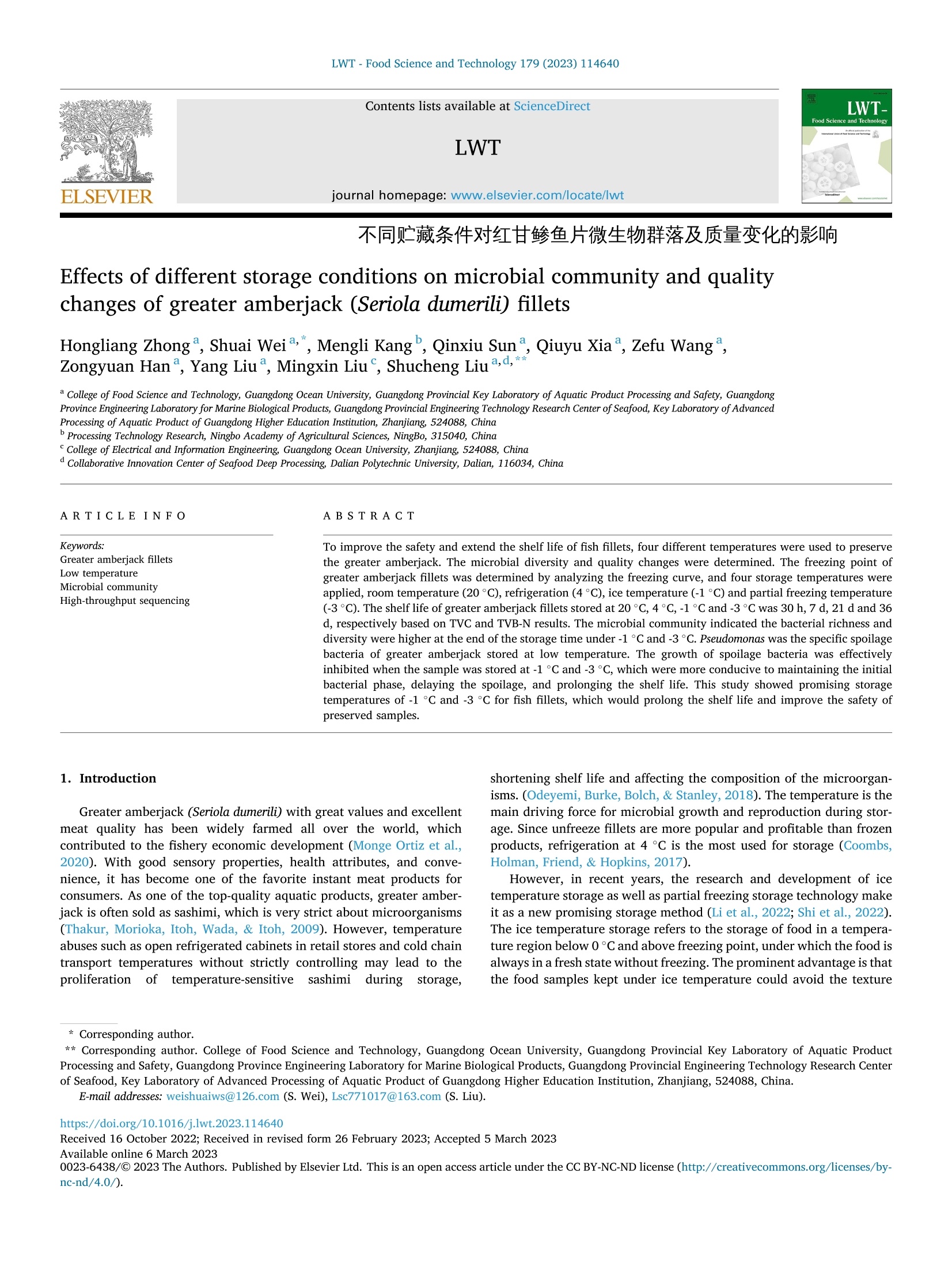
-
2/9
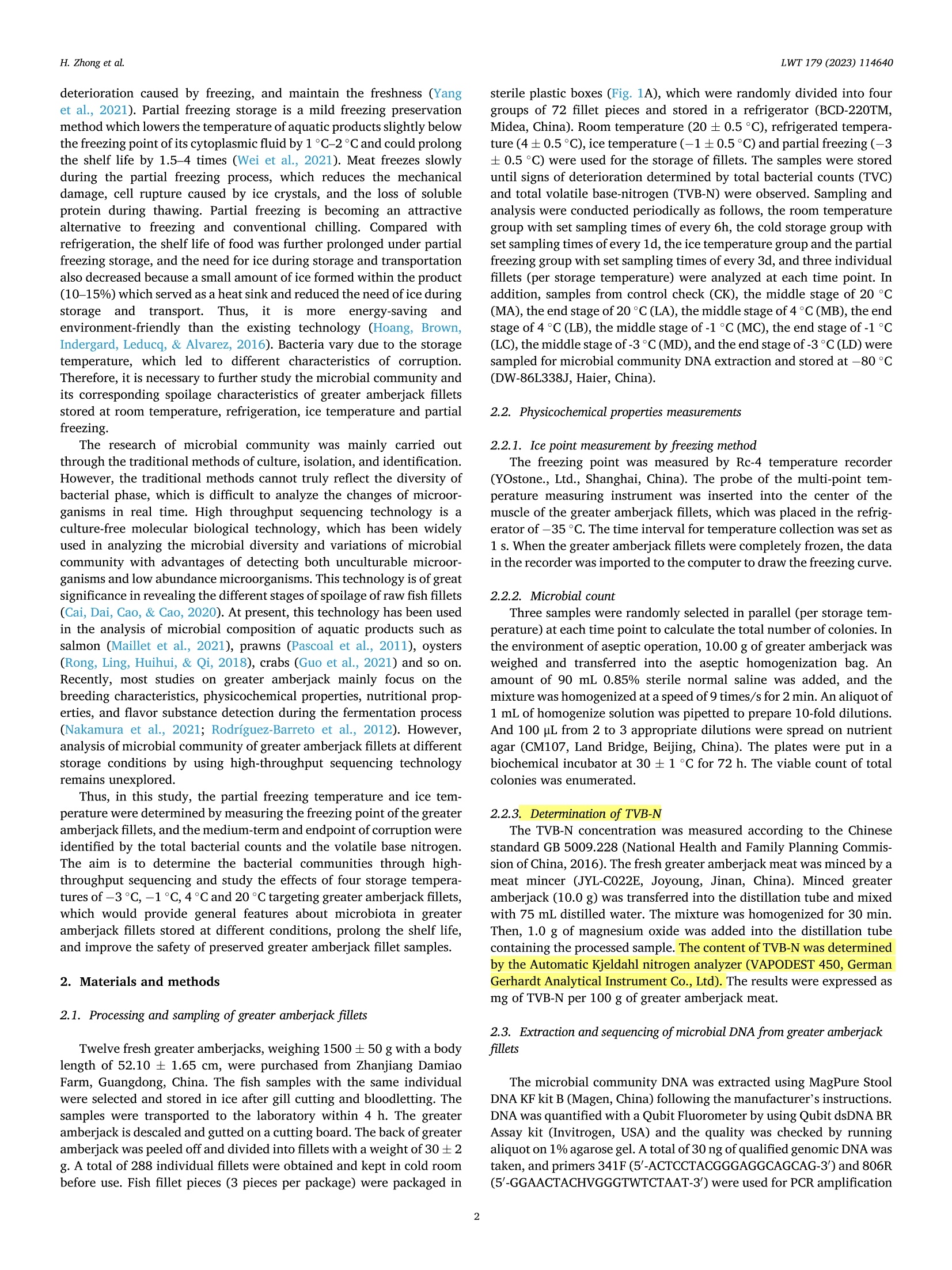
还剩7页未读,是否继续阅读?
继续免费阅读全文产品配置单
中国格哈特为您提供《红甘鲹鱼片挥发性盐基氮TVBN含量(新鲜度)的检测》,该方案主要用于生食水产品中理化分析检测,参考标准《暂无》,《红甘鲹鱼片挥发性盐基氮TVBN含量(新鲜度)的检测》用到的仪器有格哈特全自动凯氏定氮仪VAPODEST 450、格哈特快速干燥仪STL56、格哈特强力高重现振荡器LS500/RO500、特大消化管、德国移液器MM、1200ml大体积样品蒸馏管。
我要纠错
相关方案


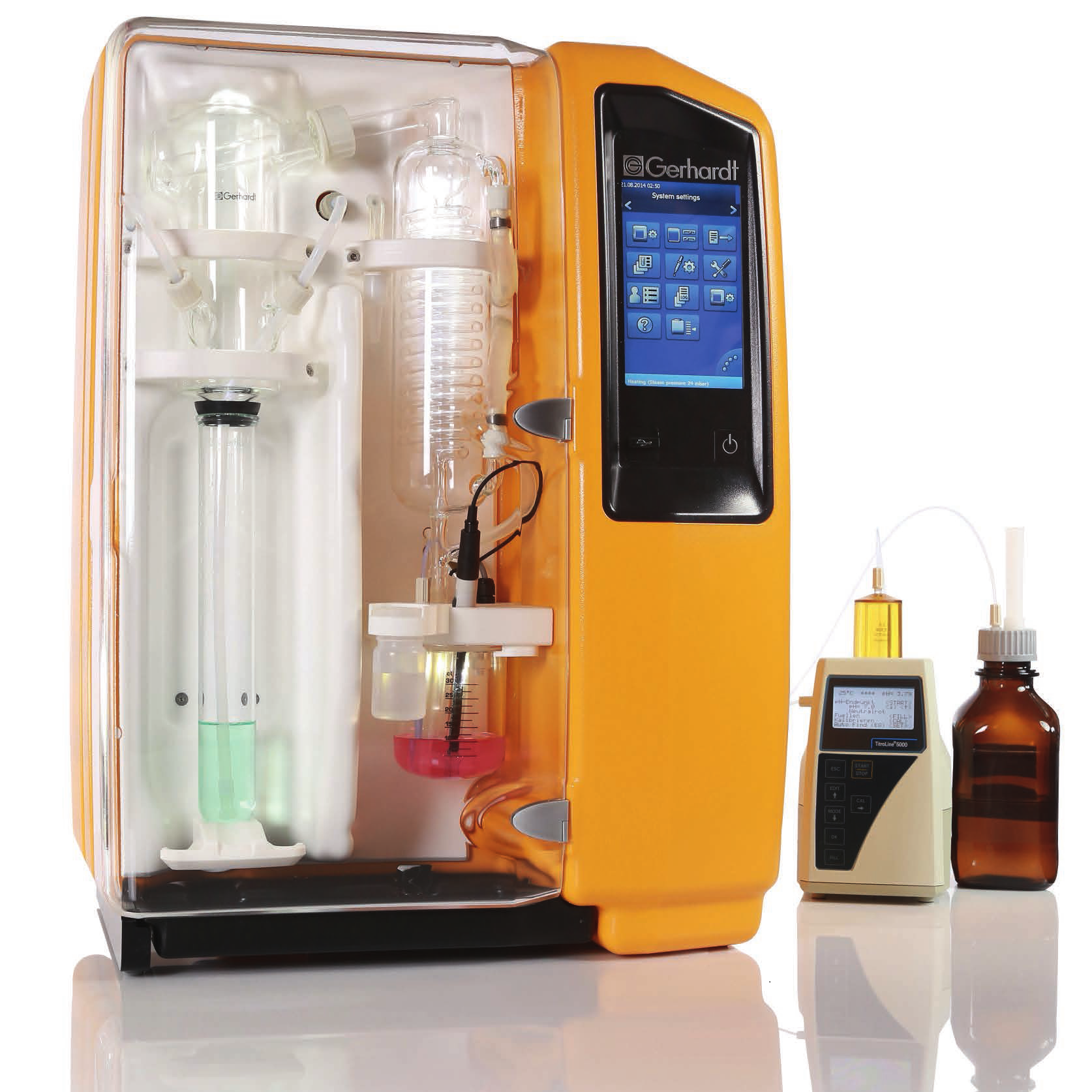

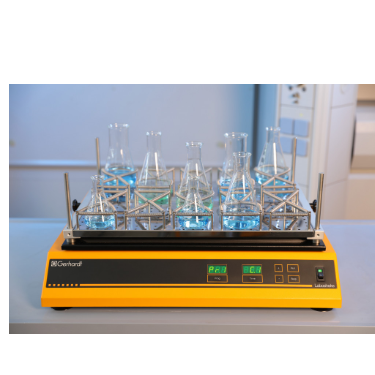
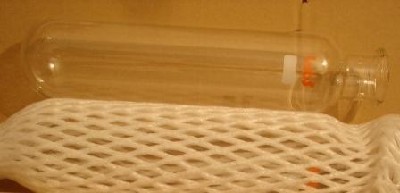
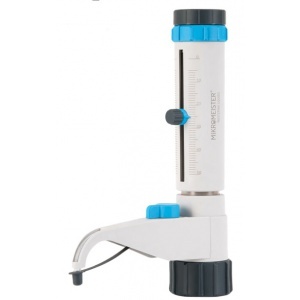
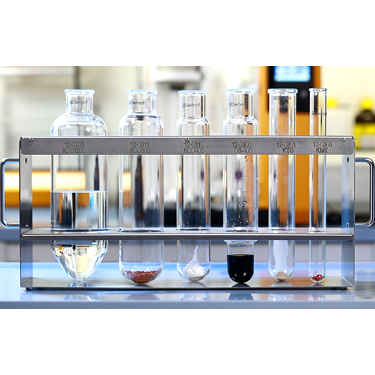


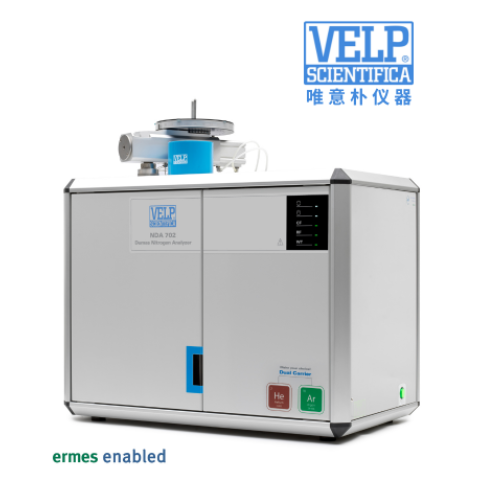


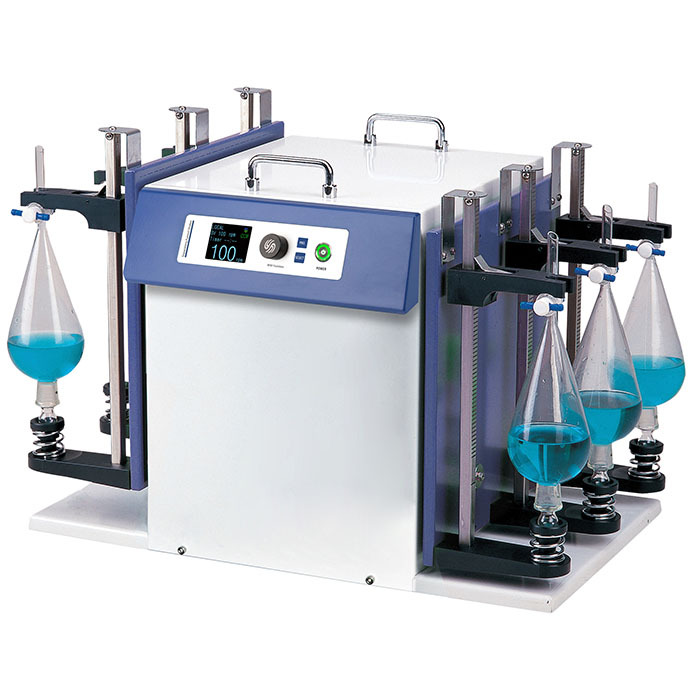
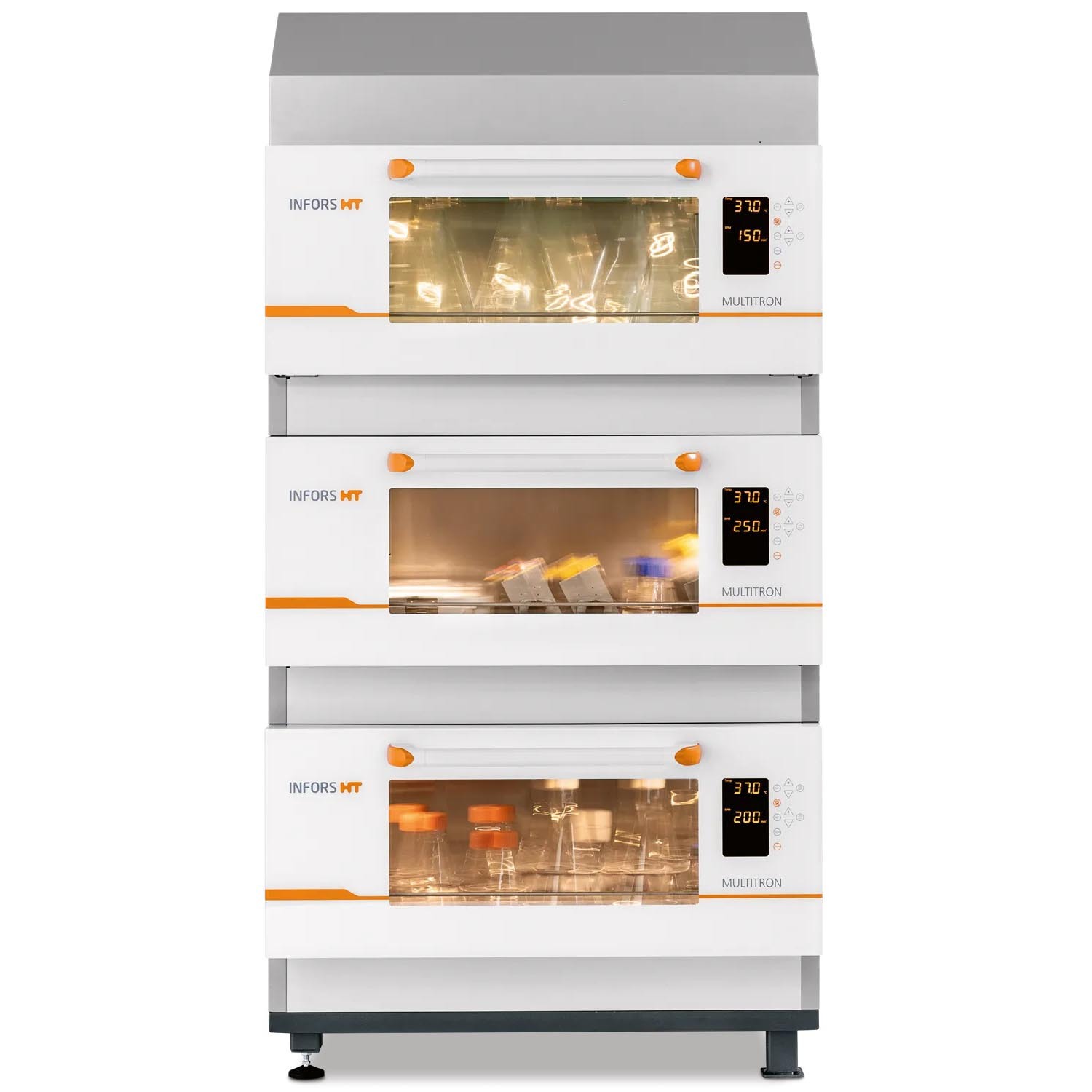
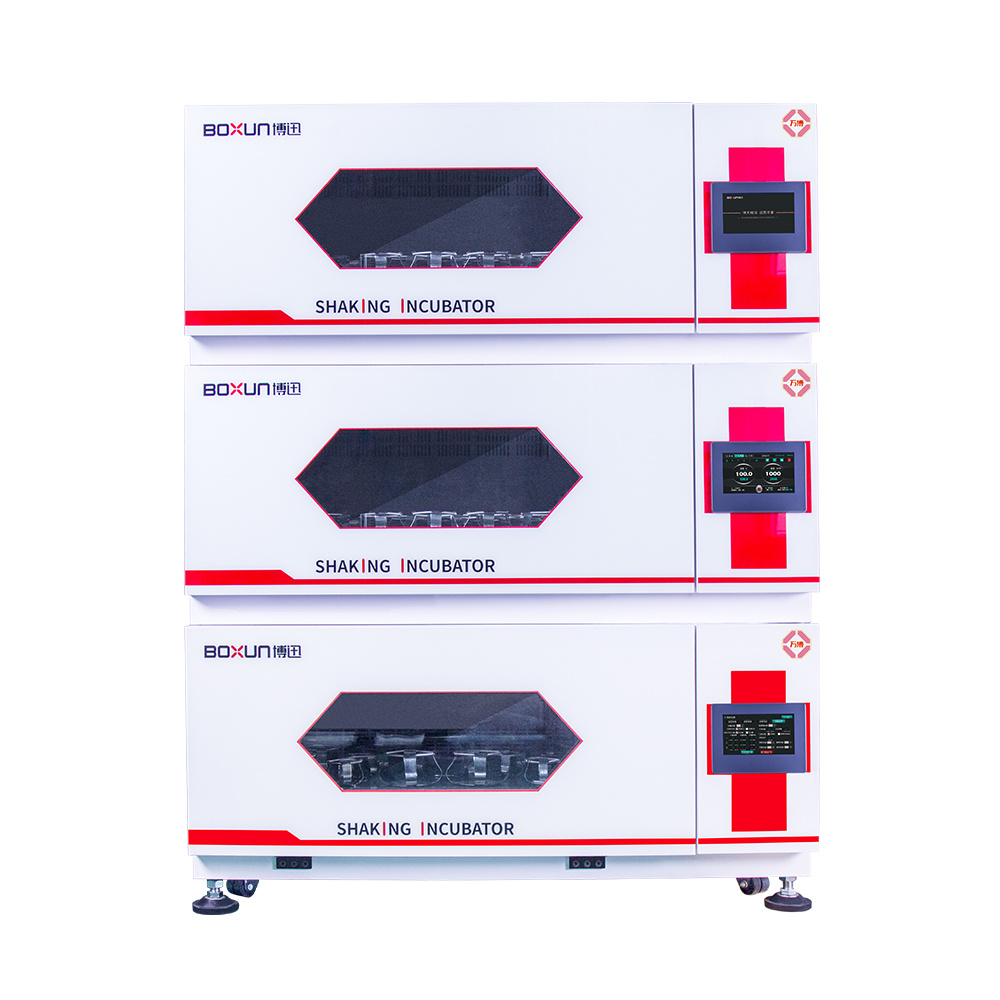
 咨询
咨询
